Managing Workgroups
To manage your list of Workgroups, click the "Workgroups" tab in the main Administrator Panel menu.
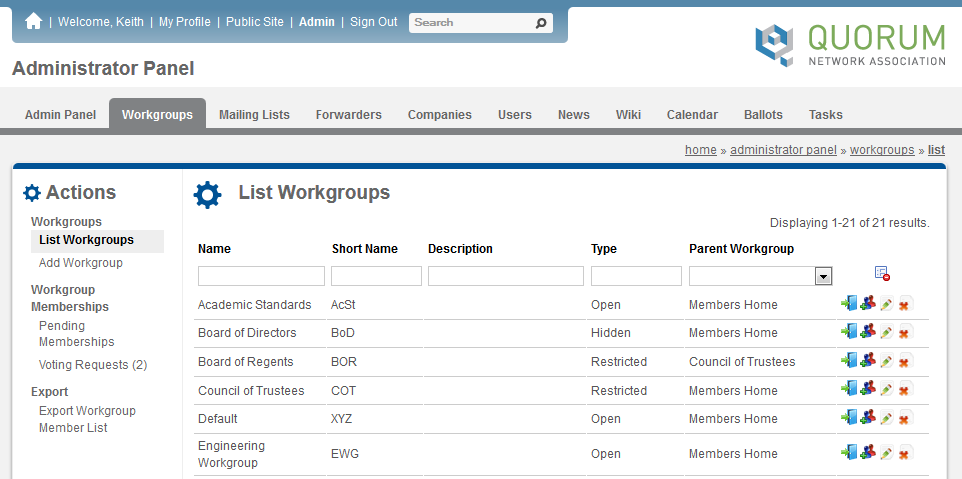
Here, you will see a list of all the Workgroups in Causeway. For each Workgroup, you may perform the following actions:
![]() Enter the Workgroup: This allows you to go to the Workgroup's home page to view its content and upload new content
Enter the Workgroup: This allows you to go to the Workgroup's home page to view its content and upload new content
![]() Manage Membership: This button allows you to edit the membership roster for the Workgroup
Manage Membership: This button allows you to edit the membership roster for the Workgroup
![]() Edit the Workgroup's settings: This button allows you to edit the basic settings of the Workgroup, such as its name, mailing list address, and membership settings.
Edit the Workgroup's settings: This button allows you to edit the basic settings of the Workgroup, such as its name, mailing list address, and membership settings.
![]() Delete the Workgroup: This button deletes the Workgroup and all its content. This is not reversible. If you click this button, you will see a warning message.
Delete the Workgroup: This button deletes the Workgroup and all its content. This is not reversible. If you click this button, you will see a warning message.
Creating a Workgroup
To create a new Workgroup, click the "Add Workgroup" link in the left menu. You will see the "Create Workgroup" page.
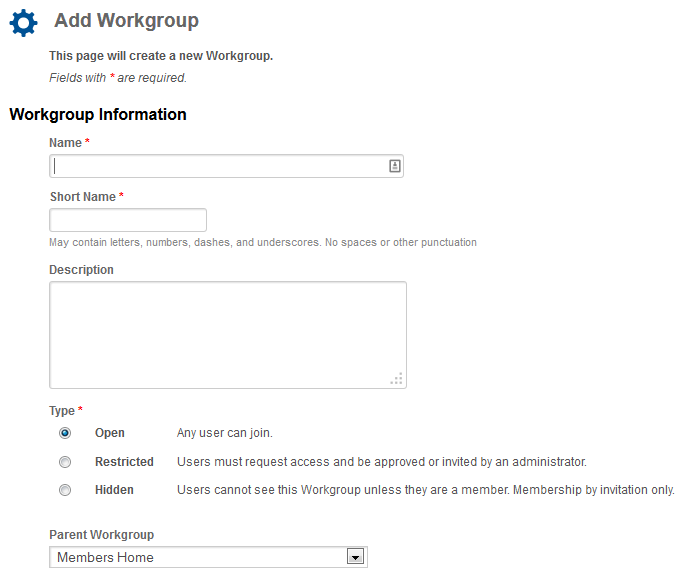
Give your new Workgroup a name, short name, and description.
The short name should be the abbreviation of your group. For example, if your workgroup is called "Technical Working Group" the abbreviation could be "TWG." The short name is used in the Web address of your workgroup, so the a workgroup with a short name of TWG would have a Web address of http://yoursite.com/wg/TWG/dashboard.
The Workgroup type determines its visibility to non-members. It also determines how a user may join. Please see this page for a description of the workgroup types.
If your new workgroup should be a sub-group of an existing group, change the "Parent Workgroup" option to show the correct parent group. Otherwise, choose the first option, "Members Home." (The name may vary depending on the name of your site's top-level Members Area.)
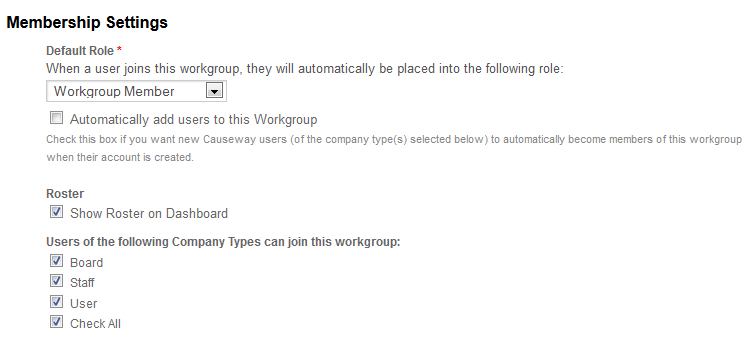
The "Membership Settings" section provides finer-grained control of users' membership options.
Default Role
The Default Role option lets you assign permissions automatically when a user joins the group. Common values are the following:
- Workgroup Member: New members will have permissions to view all content, upload documents, and edit Wiki pages and tasks (the default)
- Observer: New members will have read-only permissions. They will be able to view content but not edit.
- The other options are seldom used.
Automatic Membership
Causeway allows administrators to specify that all users from specific company type(s) should belong to a specific Workgroup. If that is the case, check the "Automatically add users to this Workgroup" box, then check the boxes below that correspond to the company type(s) which should have automatic membership.
Once you set up automatic membership, any new users from these company type(s) will become members of the Workgroup as soon as they register for a user account. This does not affect people who already have user accounts at the time the Workgroup is created.
Restricted Visibility
The alternative to automatic membership is the Restricted Visibility option. This allows you to make a Workgroup visible to only users who belong to certain company type(s). To set up restricted visibility, uncheck "Automatically add users to this Workgroup." Then, check the boxes next to only the company types who should be able to see and join the Workgroup. Any users from other company types will not see the workgroup and will not be able to join it. Users from other company types may still be added to the Workgroup by an administrator.
Roster Visibility
This checkbox controls the visibility of the "Workgroup Details" widget on the Workgroup dashboard. If you do not wish to allow group members to see the list roster, uncheck the "Show Roster on Dashboard" option. Workgroup Administrators and Workgroup Chairs will always see the widget, even if this box is unchecked.
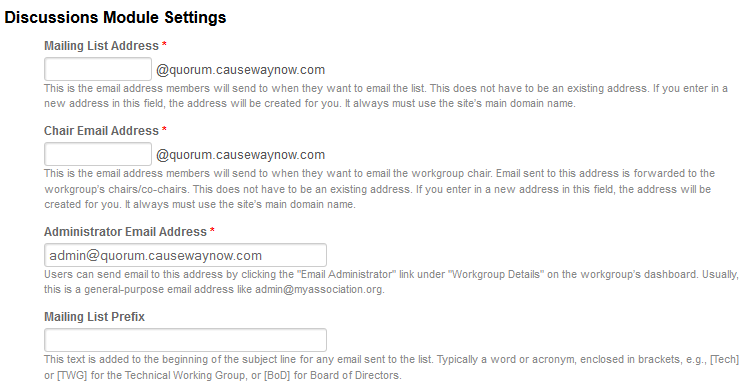
The "Discussions Module Settings" section allows you to configure the Workgroup's built-in mailing list and workgroup chair address.
Please note: the Mailing List Address and Chair Email Address must be unique and must not match any other Workgroup, Mailing List, or Email Forwarder.
The Mailing List Prefix is a label added to the email subject for any messages sent to the Workgroup's mailing list. This is used to help recipients identify which list they received a message through. It is recommended to include a prefix, but the setting is optional and you may leave it blank if you prefer not to have a prefix.
The next several options let you configure the moderation settings amd default notification settings for your Workgroup's mailing list.
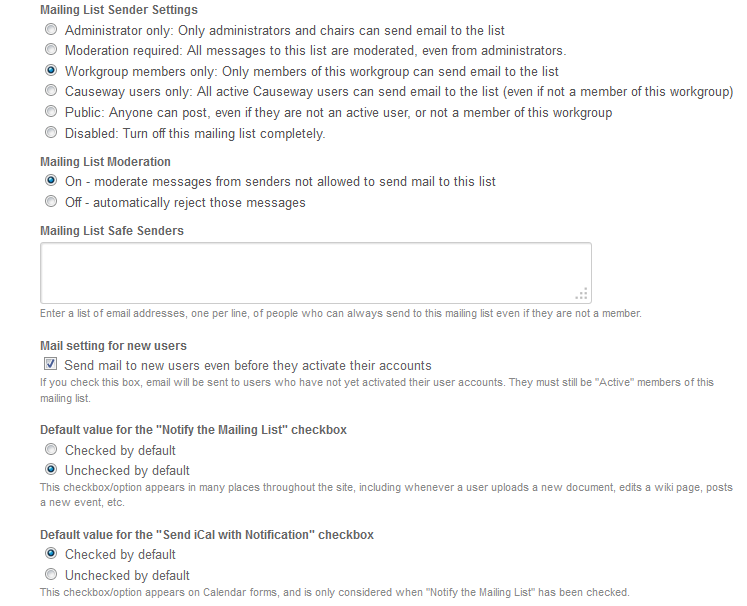
Mailing List Sender Settings controls users' permissions to send email to the list.
Mailing List Moderation lets you determine what to do with messages that do not meet the criteria for your chosen Sender Settings. If you leave this option on, any unauthorized messages will be held for moderation. If you turn this setting off, all unauthorized messages will bounce.
Mailing List Safe Senders is a list of email addresses of people who are always allowed to send email to the list. Enter a list of email addresses, one address per line. These email addresses do not need to be associated with Causeway users. Safe Senders are allowed to send email to the list regardless of the Sender Settings, and their messages are never held for moderation.
The only exception to the Moderation and Safe Senders settings is for Disabled mailing lists, which do not accept email from anyone. All messages sent to a Disabled mailing list will bounce, even if the sender is an administrator or is on the safe senders list.
